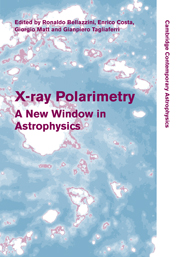Book contents
- Frontmatter
- Contents
- List of contributors
- Preface
- 1 X-ray polarimetry: historical remarks and other considerations
- Part I Polarimetry techniques
- Part II Polarized emission in X-ray sources
- Part III Future missions
- 37 Gravity and Extreme Magnetism SMEX (GEMS)
- 38 Programs of X-ray polarimetry in Italy
- 39 A polarimeter for IXO
- 40 Polarimetry with ASTRO-H soft gamma-ray detector
- 41 The Energetic X-ray Imaging Survey Telescope and its polarization sensitivity
- 42 PoGOLite: a balloon-borne soft gamma-ray polarimeter
- 43 Studies of neutron background rejection in the PoGOLite polarimeter
- 44 Observing polarized X-rays with PoGOLite
- 45 Pre-flight qualification tests of the PoGOLite detector system
- 46 The Gamma-RAy Polarimeter Experiment (GRAPE) balloon payload
- 47 POLAR: an instrument dedicated to GRB polarization measurement
- 48 Polarization detection capability of GRIPS
- 49 X-ray and γ-ray polarimetry small-satellite mission PolariS
- 50 GAP aboard the solar-powered sail mission
- 51 Hard X-ray polarimeter for small-satellite missions
- 52 Performance of hard X-ray polarimeter: PHENEX
- 53 GRB polarimetry with POET
- Author index
- Subject index
43 - Studies of neutron background rejection in the PoGOLite polarimeter
from Part III - Future missions
Published online by Cambridge University Press: 06 July 2010
- Frontmatter
- Contents
- List of contributors
- Preface
- 1 X-ray polarimetry: historical remarks and other considerations
- Part I Polarimetry techniques
- Part II Polarized emission in X-ray sources
- Part III Future missions
- 37 Gravity and Extreme Magnetism SMEX (GEMS)
- 38 Programs of X-ray polarimetry in Italy
- 39 A polarimeter for IXO
- 40 Polarimetry with ASTRO-H soft gamma-ray detector
- 41 The Energetic X-ray Imaging Survey Telescope and its polarization sensitivity
- 42 PoGOLite: a balloon-borne soft gamma-ray polarimeter
- 43 Studies of neutron background rejection in the PoGOLite polarimeter
- 44 Observing polarized X-rays with PoGOLite
- 45 Pre-flight qualification tests of the PoGOLite detector system
- 46 The Gamma-RAy Polarimeter Experiment (GRAPE) balloon payload
- 47 POLAR: an instrument dedicated to GRB polarization measurement
- 48 Polarization detection capability of GRIPS
- 49 X-ray and γ-ray polarimetry small-satellite mission PolariS
- 50 GAP aboard the solar-powered sail mission
- 51 Hard X-ray polarimeter for small-satellite missions
- 52 Performance of hard X-ray polarimeter: PHENEX
- 53 GRB polarimetry with POET
- Author index
- Subject index
Summary
The Polarized Gamma-ray Observer (PoGOLite) is a balloon-borne polarimeter based on measuring anisotropy in the azimuthal scattering angle distribution of photons in the energy range 25–80 keV. This is achieved through coincident detection of Compton scattering and photoelectric absorption within a close-packed array of phoswich detector cells (PDCs). Each PDC contains a plastic scintillator rod (main detector component), a plastic scintillator tube (active collimator) and a BGO crystal (anticoincidence shield).
A significant in-flight background is expected from atmospheric neutrons as well as from neutrons produced by interactions of cosmic rays with mechanical structures surrounding the instrument. Although this background can be reduced by introducing suitable shielding materials such as polyethylene, the shield geometry must be optimized through simulations in order to yield sufficient shielding with an acceptable increase in weight.
Geant4-based Monte-Carlo simulations have shown that a 10 cm thick polyethylene shield surrounding the PoGOLite instrument is required to sufficiently reduce the background, i.e. fake polarization events from atmospheric neutrons. In order to validate these simulations, a beam test was carried out, at which 14 MeV neutrons were used to irradiate a simple detector array with four plastic scintillators and three BGO crystals. The array was configured to mimic the PoGOLite detector geometry and also featured a polyethylene neutron shield. Here, we present details of the neutron beam test and our simulation thereof, which demonstrate that the treatment of neutron interactions within the Geant4 framework is reliable.…
- Type
- Chapter
- Information
- X-ray PolarimetryA New Window in Astrophysics, pp. 299 - 304Publisher: Cambridge University PressPrint publication year: 2010



